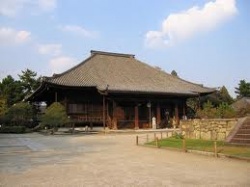Difference between revisions of "Saidai-ji"
m (Text replacement - "Category:Monasteries" to "Category:Buddhist Monasteries") |
|||
| Line 1: | Line 1: | ||
[[File:Saidai-ji0.jpg|thumb|250px|]] | [[File:Saidai-ji0.jpg|thumb|250px|]] | ||
<poem> | <poem> | ||
| − | Saidai-ji | + | [[Saidai-ji]] |
| − | [西大寺] Saidai-ji | + | [[西大寺]] [[Saidai-ji]] |
| − | The head temple of the True Word Precepts (Shingon-Ritsu) school in [[Japan]]. It was one of the seven major temples of Nara, the capital of [[Japan]] from 710 to 784. Built in 765 in response to a decree issued the previous year by Empress Shotoku, it was named Saidai-ji (West Great Temple), because it was located in the western part of the capital. It had two main halls, one enshrining an image of [[Medicine Master Buddha]] and the other, an image of [[Bodhisattva]] [[Maitreya]]. Though it enjoyed prosperity along with Todai-ji (East Great Temple) in the eastern part of the capital, Saidai-ji was damaged by a [[Fire]] in 846 and 860, and declined late in the Heian period (794-1185). The priest Eizon took up residence at Saidai-ji in 1235, and restored the temple as a center for the teachings on The [[Precepts]]. In 1502 the main buildings in the temple precinct burned down, and the temple again declined, but was revitalized by Tokugawa Ieyasu (1542-1616), the founder of the Tokugawa shogunate, who gave it financial support. Saidai-ji preserves bronze images of the four heavenly kings produced late in the Nara period (710-794), and other Buddhist [[Art]] works. | + | The head [[temple]] of the [[True Word Precepts]] ([[Shingon-Ritsu]]) school in [[Japan]]. It was one of the [[seven major temples of Nara]], the capital of [[Japan]] from 710 to 784. Built in 765 in response to a decree issued the previous year by {{Wiki|Empress}} [[Shotoku]], it was named [[Saidai-ji]] ([[West]] Great [[Temple]]), because it was located in the {{Wiki|western}} part of the capital. It had two main halls, one enshrining an image of [[Medicine Master Buddha]] and the other, an image of [[Bodhisattva]] [[Maitreya]]. Though it enjoyed [[prosperity]] along with [[Todai-ji]] ([[East]] Great [[Temple]]) in the eastern part of the capital, [[Saidai-ji]] was damaged by a [[Fire]] in 846 and 860, and declined late in the [[Heian period]] (794-1185). The [[priest]] [[Eizon]] took up residence at [[Saidai-ji]] in 1235, and restored the [[temple]] as a center for the teachings on The [[Precepts]]. In 1502 the main buildings in the [[temple]] precinct burned down, and the [[temple]] again declined, but was revitalized by [[Tokugawa Ieyasu]] (1542-1616), the founder of the {{Wiki|Tokugawa}} [[shogunate]], who gave it financial support. [[Saidai-ji]] preserves bronze images of the [[four heavenly kings]] produced late in the [[Nara period]] (710-794), and other [[Buddhist]] [[Art]] works. |
</poem> | </poem> | ||
{{R}} | {{R}} | ||
Latest revision as of 14:36, 5 July 2014
Saidai-ji
西大寺 Saidai-ji
The head temple of the True Word Precepts (Shingon-Ritsu) school in Japan. It was one of the seven major temples of Nara, the capital of Japan from 710 to 784. Built in 765 in response to a decree issued the previous year by Empress Shotoku, it was named Saidai-ji (West Great Temple), because it was located in the western part of the capital. It had two main halls, one enshrining an image of Medicine Master Buddha and the other, an image of Bodhisattva Maitreya. Though it enjoyed prosperity along with Todai-ji (East Great Temple) in the eastern part of the capital, Saidai-ji was damaged by a Fire in 846 and 860, and declined late in the Heian period (794-1185). The priest Eizon took up residence at Saidai-ji in 1235, and restored the temple as a center for the teachings on The Precepts. In 1502 the main buildings in the temple precinct burned down, and the temple again declined, but was revitalized by Tokugawa Ieyasu (1542-1616), the founder of the Tokugawa shogunate, who gave it financial support. Saidai-ji preserves bronze images of the four heavenly kings produced late in the Nara period (710-794), and other Buddhist Art works.
